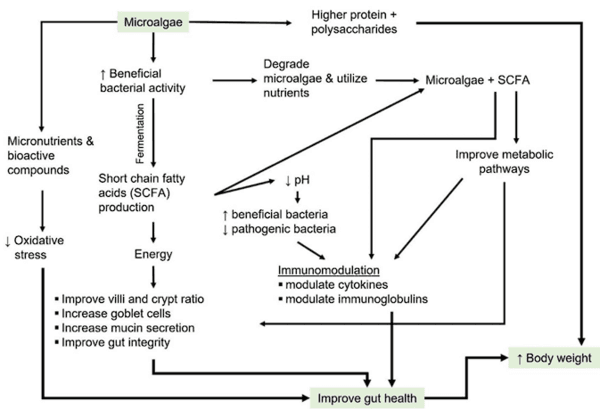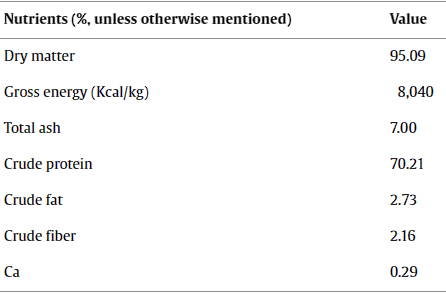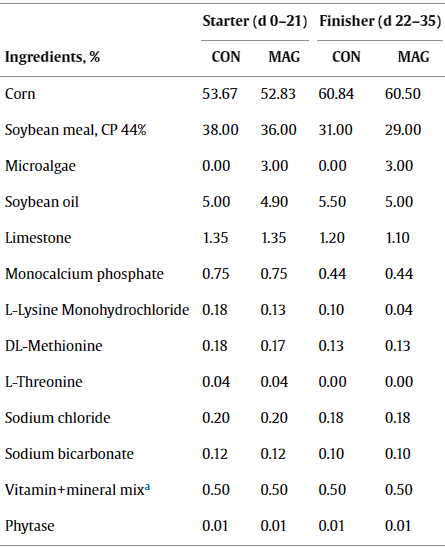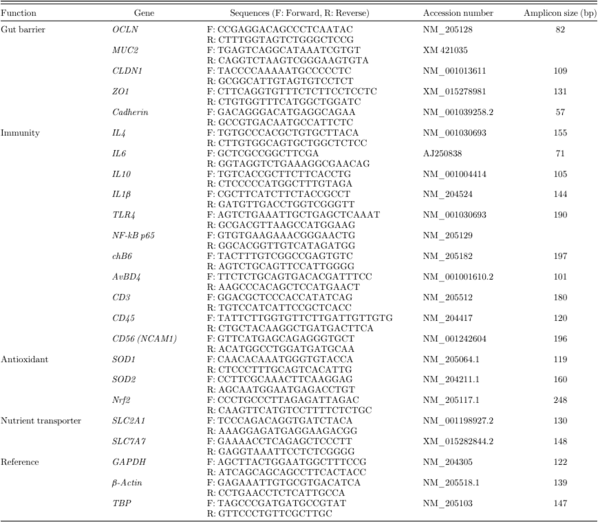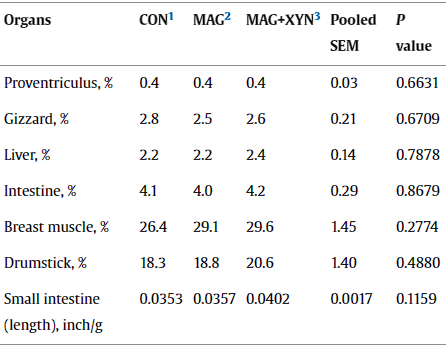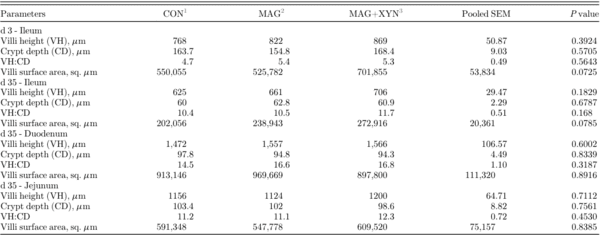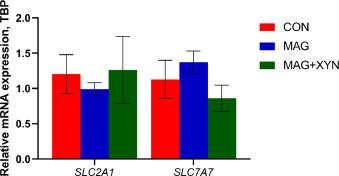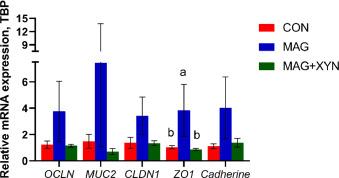INTRODUCTION
Reducing the production cost of quality meat and eggs for the ever-growing world population is a prime target of the poultry industry. Conventional feed ingredients like corn and soybean meal are widely used in broiler feeding programs, which increase the competition among food and feed and lead to raise production costs (Donohue and Cunningham, 2009; Stefanello et al., 2016). Several strategies were attempted to minimize the cost per unit production, such as feeding different feed additives, supplementation of exogenous enzymes, and alternative terrestrial feed ingredients as a full or partial replacement of corn and soybean meal for energy and protein sources, and these strategies came up with promising response (Yadav et al., 2019; Yadav and Jha, 2021). However, incorporating alternative terrestrial feed ingredients into poultry diets may embrace some challenges, such as the quality, availability, and price of the ingredients. Most of the alternative ingredients con tain a high amount of fibers and tannins along with other antinutritional factors like enzyme inhibitors and have low metabolizable energy (Alshelmani et al., 2021). The aqua-based feed ingredients are more promising and sustainable than terrestrial feed ingredients (Liu et al., 2020). The earth’s geography is dominated by water bodies that could be utilized for aqua-based feed ingredi ent production. Among aqua-based feed ingredients, microalgae are one of the best alternative feed ingredients, and they have a nutrient profile suitable for the poultry feeding program.
Table 1. Common microalgae species used in animal feed and their nutrient profile.
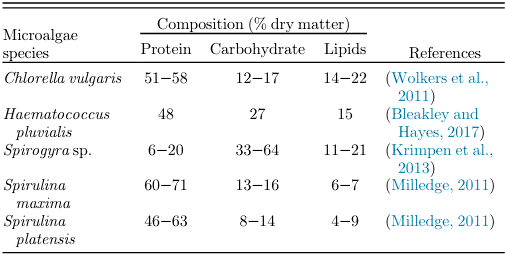
Microalgae are single-celled microorganisms found in fresh and seawater (Vale et al., 2020). It can be classified based on the size and pigments it contains. Microalgae are also considered a plant-based superfood as it con tains a high amount of proteins, carbohydrates, lipids, different pigments, and unsaturated fatty acids, which are hardly available together in any plant-based food (Vrenna et al., 2021; Terezinha Schneider et al., 2023). Besides these, microalgae are rich in amino acids and other nutrients like vitamins and carotenoids and pos sess bioactive compounds such as phycocyanin, b-caro tene, flavonoid, phycobiliproteins (b-phycocyanin and C-phycocyanin), and phenolic acid with antibacterial, antiviral, antioxidant, and anticarcinogenic properties (Farag et al., 2016; Wu et al., 2016; Saadaoui et al., 2021). However, the nutritional value of microalgae varies from species to species, and the environment in it is cultivated (Table 1). The inclusion of microalgae at a high dose works as a replacement for protein-rich feed ingredients, whereas a low dose of microalgae serves a functional value (Tavernari et al., 2018). The nutritional and functional values of microalgae promote the overall performance of broiler chickens by promoting their health status. Microalgae, such as Arthrospira, also known as Spirulina, improve the broiler’s immune sys tem, protect against different pathogens, and increase T-cell activity in the body (Sugiharto, 2020; Fries-Craft et al., 2021). The inclusion of Arthrospira platensis at different doses in the broiler diet also improves villi height (VH), crypt depth (CD), and VH to CD ratio of the small intestine (El-Hady et al., 2022). The exact mechanistic pathway of microalgae is still unclear; how ever, we have outlined the plausible pathways (Figure 1) of how microalgae may improve broiler chickens’ gut health and growth performance.
Microalgae contain 47.7% hemicellulose, 37.8% cellu lose, and 13.3% lignin (Kusmiyati et al., 2020). Due to the abundance of these nonstarch polysaccharides (NSP), microalgae are less digestible. The poultry lacks the endogenous enzymes required to digest the NSP of microalgae. However, digestibility can be enhanced by adding xylanase, an exogenous enzyme, to the diet.
Figure 1. Probable working pathways of microalgae to improve gut health and body weight of broiler chickens.
Xylanase converts xylan (complex polysaccharide) into xylose (monosaccharide). Previous studies suggested that adding xylanase to a fiber-enriched diet improved digestibility and nutrient utilization in broilers.
Therefore, we hypothesized that including microalgae (A. platensis) with or without xylanse in the broiler´s diet improves growth performance, supports the development of intestinal morphology, and boosts the immune system. The objective of this study was to assess the effect on growth performance, intestinal histomorphology, and immunity in broiler chickens when fed a diet supplemented with microalgae, with or whitout xylanase.
MATERIALS AND METHODS
All research animal care procedures were approved by the Institutional Animal Care and Use Committee of the University of Hawaii (UH), HI (Protocol#15-2274-7).
Experimental Location, Birds, and Management
A total of 162-day-old Cobb500 broiler chicks were brought from a local commercial hatchery (Asagi Hatchery Inc., Honolulu, HI). All the birds were vaccinated against Marek's disease. The birds were reared for 35 d at the Small Animal Facility of UH Manoa on floor pens, maintaining the standard environment (temperature: 18⁰C–24⁰C and relative humidity: 50 ± 5%) required for Cobb500 broilers (Cobb-Vantress, 2021), and had ad libitum access to feed and water throughout the experiment. The experimental house had an appropriate ventilation system. The photoperiod cycle was set for 23:1 h of light and dark.
Experimental Design and Diet
Immediately after the arrival of chicks, individual birds were weighed, wing tagged, and randomly allocated into one of the 3 dietary treatment groups. Each group had 6 replicates, with 9 birds in each replicate (n = 54 per group). Three different corn and soybean meal-based mash diets were formulated in 2 phases, starter (d 0–21) and finisher (d 22–35): corn–soybean meal control (CON), CON + 3% Microalgae (A. platensis, MAG), and CON + 3% microalgae with xylanase enzyme (MAG+XYN) in mash form. Microalgae, at a rate of 30 g/kg diet, were added as premix, whereas xylanase, at a rate of 16,000 BXU/Kg (i.e., 100 g/ton) of diet, was topped up. All the formulated diets met or exceeded the nutritional requirement of broiler chickens (Cobb-Vantress, 2021). Table 2 shows the nutrient profile of microalgae used in this study. Tables 3 and 4 show the ingredients used in feed formulation and their nutritional contents, respectively. The fatty acid profile of microalgae used in the study is presented in Supplementary Table 1.
Table 2. Nutrient composition of microalgae (Arthrospira platensis) used in the study.
Table 3. Ingredients composition of experimental diets.
⁎
The diets MAG in both phases were top-dressed with 100g xylanase per ton of diet to make MAG+XYN diets in the respective phase. Expected xylanase activity was 16000 BXU/kg of feed.
a
Provides the following nutrients (per kg of diet): vitamin A (trans-retinyl acetate), 10,000 IU; vitamin D3 (cholecalciferol), 3,000 IU; vitamin E (all-rac-tocopherol-acetate), 30 mg; vitamin B1, 2 mg; vitamin B2, 8 mg; vitamin B6, 4 mg; vitamin B12 (cyanocobalamin), 0.025 mg; vitamin K3 (bisulfatemenadione complex), 3mg; choline (choline chloride), 250 mg; nicotinic acid, 60 mg; pantothenic acid (D-calcium pantothenate), 15 mg; folic acid, 1.5 mg; betaíne anhydrous, 80 mg; D-biotin, 0.15 mg; zinc (ZnO), 80 mg; manganese (MnO), 70 mg iron (FeCO3), 60 mg; copper (CuSO4·5H2O), 8 mg; iodine (KI), 2 mg; selenium (Na2SeO3), 0.2 mg.
Table 4. Nutrient composition of experimental diets.
Chemical Analysis and Enzymes Activities
The gross energy of samples was determined according to the standard procedures of the Association of Officials Analytical Chemists (AOAC, 2006) using an oxygen bomb calorimeter (Parr Bomb Calorimeter 6200, Parr Instrument Co., Moline, IL). All other chemical profiles were analyzed by Near Infra-red Reflectance Spectroscopy and enzyme activity by enzyme-linked immunoassay method at the AB Vista Innovation and Technology Center (Tredomen Park, Ystrad Mynach, UK).
Growth Performance and Relative Weight of the Organs
The body weight (BW, g) of individual birds, pen-wise supplied feed, and leftover feed were recorded weekly (on d 0, d 7, d 14, d 21, d 28, and d 35). The collected data were used to calculate the average daily gain (ADG, g), average daily feed intake (ADFI, g), and feed conversion ratio (FCR). The total feed intake by the birds in a pen was divided by the number of birds in the pen to get ADFI. The total body weight gain of the birds in a pen was divided by the bird-pen days to calculate the ADG for the birds in individual pens. The FCR was calculated as the ratio of ADG and ADFI for each pen. The number of birds in a pen during a week was corrected for any mortality. The number of days birds were alive and consumed feed in a pen was considered as the pen-days number for a pen during a week.
On d 35, one bird per replicate was randomly selected to record the relative organs’ weight against total body weight and to measure the length of intestinal segments. All the birds were euthanized using CO2 gas. After euthanization, the birds were dissected, and the weight of the proventriculus, gizzard, liver, intestine, breast muscle, and drumstick, and the length of the small intestine were measured.
Intestinal Histomorphology
Approximately 1 cm of the duodenum, jejunum, and ileum (from a position that is located at half of the length between Meckel's diverticulum and ileocecal junction) sections were collected, digesta was flushed with distilled water and then stored in 10% Neutral Buffered Formalin for histomorphological analysis on d 3 and d 35 (one bird per replicate). The stored tissue samples were processed for paraffin block embedding and sectioned at 5 μm thickness to prepare slides (3 replicates/sample) in the Histopathology core facility, John A. Burns School of Medicine, UHM. Later the prepared slides were processed with Hematoxylin and Eosin staining. The stained slides were observed to measure VH, CD, and villi width (VW) using a microscope (Olympus BX43, Olympus Co, Tokyo, Japan) with 8× objective lens for the ileum and 4× objective lens for the duodenum and jejunum. The microscope was fitted with a camera and image processing system (Infinity Analyze software, Lumenera Corporation, Ottawa, ON, Canada). The measurement of VH (distance from the tip of the villus to the crypt) and CD (distance from the villus base to the submucosa) were measured following the method described by Berrocoso et al. (2017). After measuring the VH and CD, the ratio between VH and CD was calculated. The villi surface area (VSA) was calculated from VH and VW, using the formula VSA = 2π × (VW/2) × VH, described by Sakamoto et al. (2000).
RNA Extraction, Reverse Transcription, and Real-Time Quantitative PCR
Approximately 1 cm of ileum section was collected in cryovial from each pen (1 bird per replicate) and immediately snap-frozen into liquid nitrogen and transferred to −80°C to prevent degradation. Total RNA was extracted using Trizol reagent (ThermoFisher Scientific, Carlsbad, CA, Catalog number: 15596018) following the manufacturer's instructions. RNA concentration was determined using nanodrop (ThermoFisher Scientific, Madison, WI, Catalog Number: ND-ONE-W).
The High Capacity cDNA Reverse Transcription Kit (ThermoFisher Scientific, Foster City, CA, Catalog Number: 4368814) was used for cDNA synthesis from the template of 1,000 ng total RNA extracted from each sample. The standard time and temperature for incubation were as such the company protocol describes.
Real-time quantitative PCR (qPCR) was conducted on QuantStudio 3 (ThermoFisher Scientific, Foster City, CA, Catalog number: A28567) using PowerUp SYBR Green Master Mix (ThermoFisher Scientific, Foster City, CA, Catalog number: A25742). For amplification, synthesized cDNA was used as a template. The qPCR amplification condition was set as previously described by Singh et al. (2022). The cycle threshold (Ct) value was determined, and the expression of target genes was analyzed using the 2−ΔΔCt method (Livak and Schmittgen, 2001) with reference gene TATA-binding protein (TBP). However, we compared the Ct values from 2 other reference genes Glyceraldehyde 3-phosphate dehydrogenase (GAPDH) and Beta (β)-Actin, aside TBP. The qPCR showed the most consistent Ct values for TBP. Finally, TBP was chosen as the housekeeping gene for all the gene expression analysis in this study. The oligonucleotide primers used for amplification are shown in Table 5.
Table 5. Primers used to quantify the expression of genes using
qPCR.
Statistical Analysis
The data of growth performance, relative organs weight, and histomorphology were analyzed in GraphPad Prism version 8.4.2 for Windows (GraphPad Software, San Diego, CA). The relative expression of genes was analyzed in RStudio version 2022.07.2. The data were checked for normality and log transferred prior to conducting one-way ANOVA. Tukey's multiple comparison test was performed to compare the means among the treatment groups. The significance level was set at P < 0.05, and the P < 0.10 was considered a trend. The results were expressed as the mean and pooled standard error of the mean (SEM).
RESULTS
Growth Performance and Relative Organ Weight
The phase-wise growth performance is presented in Table 6. The BW, ADG, and ADFI were significantly higher (P < 0.05) in MAG and MAG+XYN compared to the CON group. However, there was no significant difference in the growth performance variables (P > 0.05) between MAG and MAG+XYN groups. Though the diets did not show significant differences for FCR (P > 0.05), a trend in improving FCR was observed in the MAG group, followed by MAG+XYN and CON groups during the starter phase.
Table 6. Effect of diets on growth performance of broilers.
1 Control.
2 3% Microalgae.
3 3% Microalgae + Xylanase.
Data are presented as the least square means of 6 replicate pens.
Different letters within a row represent significant difference at P < 0.05.
The effect of diets on relative organs’ weight and length and carcass weight is presented in Table 7. Although the results were not statistical difference (P > 0.05), there was a substantial numerical difference among treatments. The weight of breast muscle and drumstick was the highest in MAG+XYN, followed by MAG and CON. The length of the small intestine also followed a similar trend. However, regarding liver weight and intestinal length, MAG+XYN showed an increase in the values, followed by CON and MAG groups. The proventriculus and gizzard were heavier in CON, followed by MAG+XYN and MAG groups.
Table 7. Effect of diets on relative organs’ weight, carcass weight, and length of small intestine of broiler, compared to the final body weight on d 35.
1 Control.
2 3% Microalgae.
3 3% Microalgae + Xylanase.
Data are presented as the least square means of 6 replicate pens. All the values are calculated relative to the final body weight of the birds.
Intestinal Histomorphology
The effect of diets on intestinal histomorphology is presented in Table 8. On d 3 (for the ileum) and d 35 (for duodenum, jejunum, and ileum), compared to CON diet MAG and MAG+XYN diets had a higher ratio of villi height and crypt depth except for MAG group of the jejunum on d 35, though the changes were not statistically significant (P > 0.05). There was a trend for higher villi surface area of the ileum on d 3 and d 35.
Table 8. Effects of diets on intestinal histomorphology of broilers on d 3 and d 35.
1 Control.
2 3% Microalgae.
3 3% Microalgae + Xylanase.
Data are presented as the least square means of 6 replicate pens.
Ileal Gene Expression
The relative expression of different genes related to the gut barrier, immunity, antioxidant, and nutrient transportation from ileal tissue are presented in Figure 2, Figure 3, Figure 4, Figure 5 (d 3) and in Figure 6, Figure 7, Figure 8, Figure 9 (d 35). The expression of Occludin (OCLN), Mucin 2 (MUC2), Claudin-1 (CLDN1), Interleukin-4 (IL4), Interleukin-6 (IL6), Interleukin-10 (IL10), Interleukin-1beta (IL1β), Toll-like receptor 4 (TLR4), Nuclear factor-kappa B (NF-kB p65), Chicken B-cell marker 6 (chB6), Avian beta-defensin 4 (AvBD4), Cluster of differentiation 3 (CD3), Cluster of differentiation 45 (CD45), Superoxide dismutase 1 (SOD1), Superoxide dismutase 2 (SOD2), Nuclear factor erythroid 2–related factor 2 (Nrf2), Solute carrier family 2 member 1 (SLC2A1) genes showed no significant differences among the treatments. However, the expressed values showed that the MAG and MAG+XYN-fed birds had higher expression of most of these genes than the birds from the CON group. Zonula occludens-1 (ZO1), Cluster of differentiation 56 (CD56), and Solute carrier family 7 member 7 (SLC7A7) genes were significantly changed (P < 0.05) in MAG group.
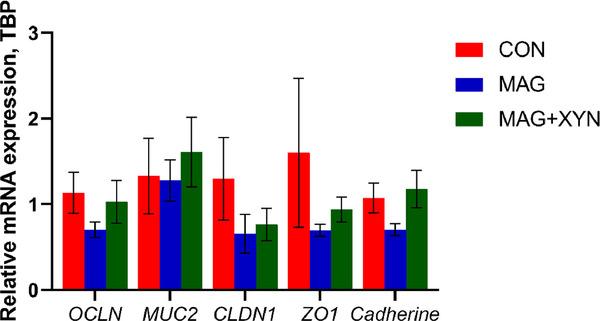
Figure 2. Relative gene expression of gut barrier genes in ileum on d 3 based on reference gene
TBP. X-axis represents the name of gut barrier-related genes, and Y-axis represents their expression in the ileum. The error bar in the graph represents the standard deviation. Abbreviations:
CLDN1, Claudin-1; MUC2, Mucin 2; OCLN, Occludin; TBP, TATA box binding protein; ZO1, Zonula occludens-1.
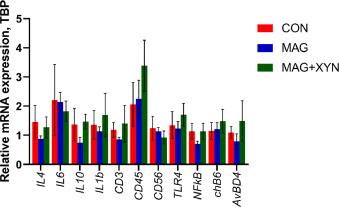
Figure 3. Relative gene expression of immune genes in ileum on d 3 based on reference gene TBP. X-axis represents the name of immune-related genes, and Y-axis represents their expression in the ileum. The error bar in the graph represents the standard deviation. Abbreviations:
AvBD4, avian beta-defensin 4; CD3, cluster of differentiation 3; CD45, cluster of differentiation 45; CD56, cluster of differentiation 56; chB6, chicken B-cell marker 6; IL10, Interleukin-10; IL1β, Interleukin-1beta; IL4, Interleukin-4; IL6, Interleukin-6; NF-kB p65, nuclear factor-kappa B; TBP, TATA box binding protein; TLR4, toll-like receptor 4.
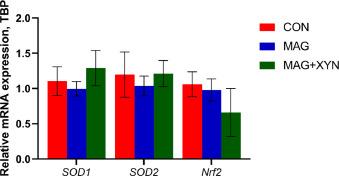
Figure 4. Relative gene expression of antioxidant genes in ileum on d 3 based on reference gene TBP. X-axis represents the name of antioxidant-related genes, and Y-axis represents their expression in the ileum. The error bar in the graph represents the standard deviation. Abbreviations: Nrf2, nuclear factor erythroid 2-related factor 2; SOD1, superoxide dismutase 1; SOD2, superoxide dismutase 2; TBP, TATA box binding protein.
Figure 5. Relative gene expression of nutrient transporter genes in ileum on d 3 based on reference gene TBP. X-axis represents the name of nutrient transport-related genes, and Y-axis represents their expression in the ileum. The error bar in the graph represents the standard deviation. Abbreviations:
SLC2A1, solute carrier family 2 member 1; SLC7A7, solute carrier family 7 member 7; TBP, TATA box binding protein.
Figure 6. Relative gene expression of gut barrier genes in ileum on d 35 based on reference gene TBP. X-axis represents the name of gut barrier-related genes, and Y-axis represents their expression in the ileum. The error bar in the graph represents the standard deviation. Different letters above the bars represent significant differences between treatments at P < 0.05. Abbreviations: CLDN1, Claudin-1; MUC2, Mucin 2; OCLN, Occludin; TBP, TATA box binding protein; ZO1, Zonula occludens-1.
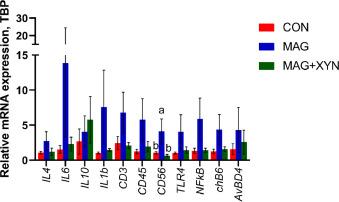
Figure 7. Relative gene expression of immune genes in ileum on d 35 based on reference gene TBP. X-axis represents the name of immune-related genes, and Y-axis represents their expression in the ileum. The error bar in the graph represents the standard deviation. Different letters above the bars represent significant differences between treatments at P < 0.05. Abbreviations: AvBD4, avian beta-defensin 4; CD3, cluster of differentiation 3; CD45, cluster of differentiation 45; CD56, cluster of differentiation 56; chB6, chicken B-cell marker 6; IL10, Interleukin-10; IL1β, Interleukin-1beta; IL4, Interleukin-4; IL6, Interleukin-6; NF-kB p65, nuclear factor-kappa B; TBP, TATA box binding protein; TLR4, toll-like receptor 4.
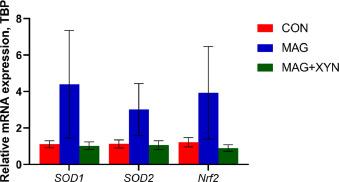
Figure 8. Relative gene expression of antioxidant genes in ileum on d 35 based on reference gene TBP. X-axis represents the name of antioxidant-related genes, and Y-axis represents their expression in the ileum. The error bar in the graph represents the standard deviation. Abbreviations: Nrf2, nuclear factor erythroid 2-related factor 2; SOD1, superoxide dismutase 1; SOD2, superoxide dismutase 2; TBP, TATA box binding protein.
Figure 9. Relative gene expression of nutrient transporter genes in ileum on d 35 based on reference gene TBP. X-axis represents the name of nutrient transport-related genes, and Y-axis represents their expression in the ileum. The error bar in the graph represents the standard deviation. Different letters above the bars represent significant differences between treatments at P < 0.05. Abbreviations: SLC2A1, solute carrier family 2 member 1; SLC7A7, solute carrier family 7 member 7; TBP, TATA box binding protein.
DISCUSSION
Microalgae are potential alternative animal feed ingredients. Due to their nutritional and functional properties, they have been prioritized to be investigated for suitability in poultry production. In this experiment, either alone or with xylanase, the addition of microalgae showed a significant increment in the body weights in both the starter and finisher dietary phases. However, there was no additional benefit for body weight gain due to xylanase addition. The nutritional richness and functional components of microalgae might be a reason for better growth in treatment groups (Farag et al., 2016; Patel et al., 2021). Other studies also found an improvement in final BW when A. platensis was added to the broiler's diet (El-Bahr et al., 2020; Ismita et al., 2022). The interaction of microalgae in poultry feed with xylanase enzyme is still unclear. We expected that the addition of xylanase would further increase the body weight of birds, but the expectation was not met in this study. It might be due to the minimal presence of cellular xylan and minimal conversion of it to xylose, a desired sugar by the microbes for energy production. Bobin-Dubigeon et al. (1997) showed that endo-xylanase releases only 69% of glucose and xylose residue from the resistant cell wall of microalgae Ulva intestinalis. Moreover, xylanase increases digesta viscosity preventing its further action (Pestana et al., 2020), and also nonprotein components of microalgae inhibit lipase activity (Kishibuchi et al., 2019). It also suggests that xylanase and β-glucanase have a lower tendency to break down the cell wall of microalgae. This might be a possible reason for no significant changes in BW after using xylanase in the microalgae diet.
The green color of the feed that resulted from the addition of microalgae could influence the birds’ appetite and increase the feed intake, which could reflect in increased body weight, as previously reported by Farghly and Abdelfattah (2017), and the higher feed intake in MAG and MAG+XYN groups compared to the CON group aligns the aforementioned findings. Better feed consumption response has been recorded in a poultry house with white room light and a red- and green-colored diet (Rierson, 2011), which aligns with the light and dietary reference of our study. In contrast to the CON group, the FCR of MAG and MAG+XYN treatments was improved, although statistically nonsignificant. The past result showed that green feed significantly increases FCR (Gulizia and Downs, 2021). Though xylanase had no apparent effect in the particular group, the nutritional richness of microalgae and bioactive components might affect the underlying physiological mechanisms, improving the FCR (Chaudhary et al., 2023).
This study found no significant changes in relative carcass weight, gastrointestinal tract weight, and ileal length among the treatment groups. However, there was a numerical increase in the weight of breast and drumstick in the MAG and MAG+XYN groups compared to the CON group. The increase in the weight of muscles may be due to the presence of a higher amount of protein along with other bioactive compounds and fatty acids in A. platensis (Peiretti and Meineri, 2011; Farag et al., 2016). The weight of the proventriculus, liver, intestine, and length of the ileum were increased numerically in the MAG+XYN group, followed by CON and MAG groups. Studies found that adequate dietary fiber, a fermentable carbohydrate with prebiotic functions, plays a critical role in the development of the digestive system (Jha and Mishra, 2021). But the weight of gizzard was higher in the CON diet than in the diets with microalgae. An increase in feed particle size enhances the size of the gizzard (Jha and Mishra, 2021). In our study, we fed broilers in mash form, and the microalgae were in powdered form, so the CON diet had comparatively bigger particles.
The major digestion and nutrient absorption in broilers occur in the small intestine. So, understanding the quality of the small intestine is critical. The study found a numerical improvement in villi height and a decrease in crypt depth in MAG and MAG+XYN groups compared to the CON group. The improvement of villi height results in the better absorption of nutrients, and as a result, the study found a significant improvement in BW gain. A study on broiler chickens with different microalgae species (Tysochrysis lutea, Tetraselmis chuii, Porphyridium cruentum) also reported the improvement of gut morphology, especially of duodenum and ileum (Šefcová et al., 2021). The potential reason for the improvement in gut morphology in the study might be due to the presence of oligosaccharides in A. platensis. Oligosaccharides bind with a side chain of mucin that prevent bacterial adhesion to the gut epithelium and protect against epithelial damage (Cornick et al., 2015).
This study reports the relative expression of different genes related to the gut barrier (OCLN, MUC2, CLDN1, ZO1, and Cadherin), immunity (IL1b, IL4, IL6, IL10, TLR4, NFkB, chB6, AvBD4, CD4, CD45, and CD56), antioxidant (Nrf2, SOD1, and SOD2), and nutrient transportation (SLC2A1 and SLC7A7) on d 3 and d 35. On d 3, the expression of all genes related to the gut barrier, immunity, antioxidant, and nutrient transport was inconsistent, even within the same category. Such variation in the expression of genes might be due to the early age and biological variation of the birds. Perhaps, the period observed is not long enough to conclude the effect of microalgae on gene expression. The study found a significantly higher expression of gene ZO1 in the MAG group compared to CON and MAG+XYN groups. The ZO1 gene helps maintain the integrity of the tight junctions and prevents any passing of bacteria and toxins into the bloodstream. In addition, ZO1 also interacts with other proteins to regulate the permeability of epithelium. The change in the relative expression of the MUC2 gene in the MAG group also represents the positive effects on the gut health of the broiler. The presence of mucins in the gut is vital for the lubrication of feed and the prevention of pathogens, toxins, or environmental irritants (Grondin et al., 2020). The study also found a higher expression of the AvBD4 gene in the MAG group, followed by the MAG+XYN and CON group. AvBD4 is a 14-member family of antimicrobial peptides and well known for broad antimicrobial activity in the innate immune system (Sugiharto, 2020). The expression of gene AvBD4 represents the resistance of broilers against salmonella. The higher expression of AvBD4 in the microalgae-fed group might result due to the presence of bioactive compounds in microalgae. The study found a significant increase in the expression of CD56, also known as neural cell adhesion molecule that maintains cell–cell interaction and cell signaling. An increased expression of CD56 is associated with reduced inflammatory bowel disease or inflammatory disorders of the gut. CD56 also acts in regulating immune responses in the gut. Antioxidant gene Nrf2, also known as a master regulator of oxidation during environmental stress, was highly expressed in the microalgae-added diets. This expression suggests that microalgae have the potential to fight against oxidative stress. Nrf2 also plays a critical role in maintaining intestinal integrity and mucosal barrier by regulating reactive oxygen species (Wen et al., 2019). The SLC2A1 and SLC7A7 genes, which are linked to nutrient transport, were also observed. SLC7A7, which is responsible for the transportation of L-amino acids, was significantly higher in the MAG group, followed by MAG+XYN and CON groups. The increased expression of SLC7A7 was attributed to higher nutrient absorption and improved growth performance of broilers in the MAG and MAG+XYN groups. The higher expression of glucose transporter and L-amino acid transporter genes in the microalgae group might be due to the higher villi height in these groups compared to the control group.
In conclusion, the dietary supplementation of microalgae at an adequate level has the ability to improve growth performance (BW, ADG, ADFI, and FCR), relative carcass and organ weight, gut structure (VH and CD), and ileal gene expression related to immunity, gut barrier functions, antioxidant activities, and nutrient transportation. This study did not find any significant changes in the outcomes due to xylanase addition to a diet containing microalgae. Further studies could assess the effect of different concentrations of xylanase inclusion on a diet containing microalgae. Regardless of xylanase addition, microalgae supplementation into a diet has the potential to promote sustainable and healthy broiler production, and the functional properties of microalgae could be credited for the benefits.

